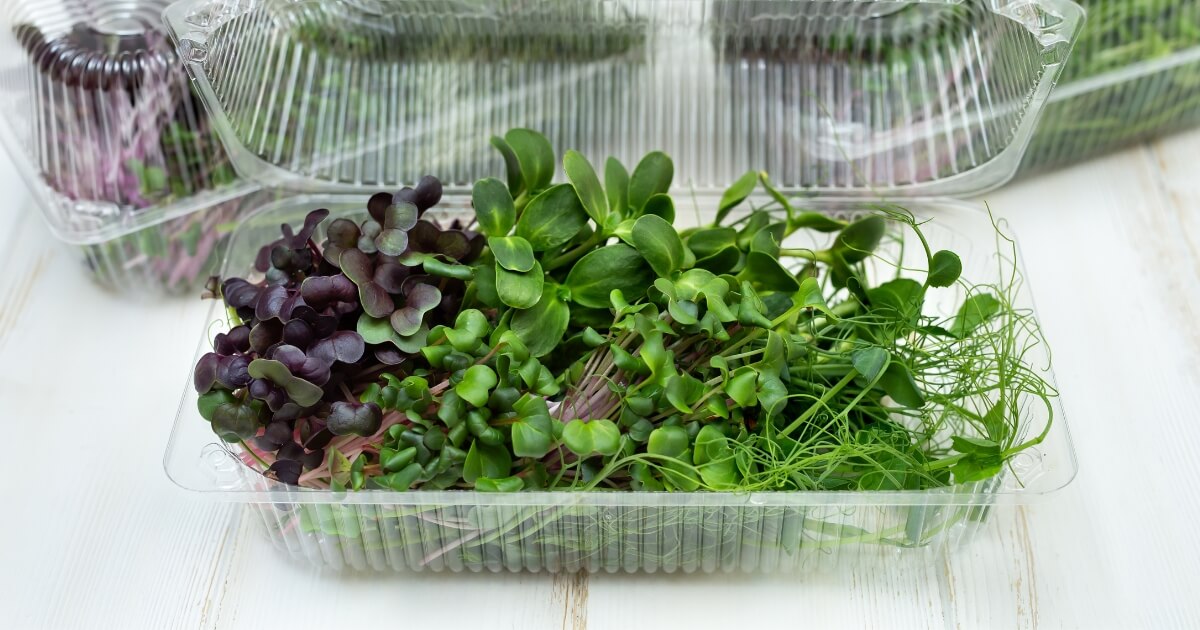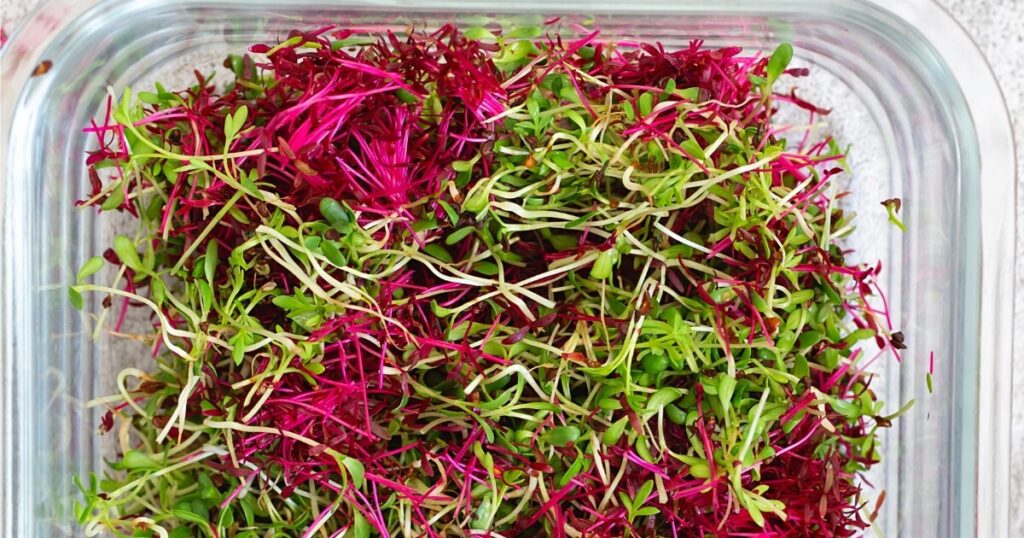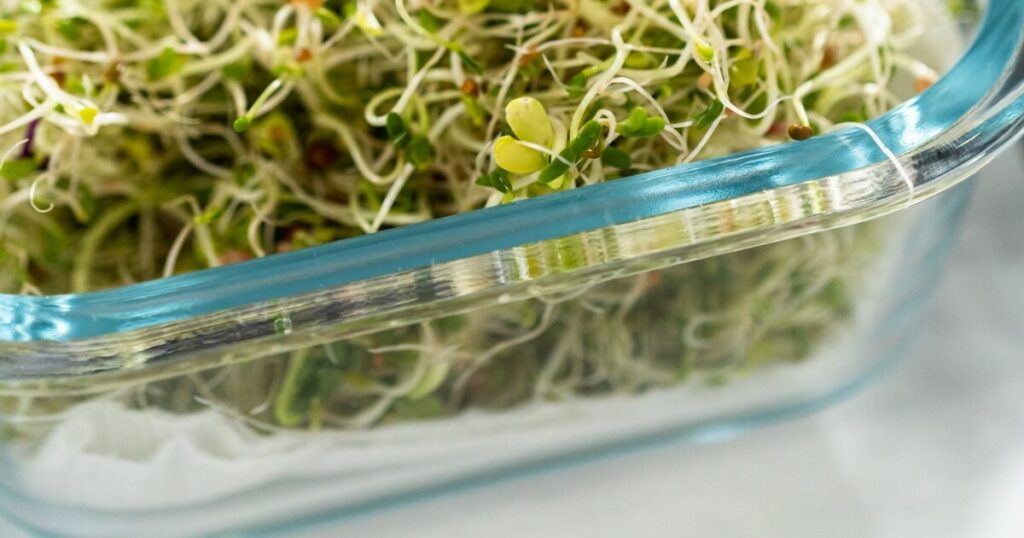You want those tiny leaves to stay as vibrant and nutrient-dense as they were when you snipped them.
Keeping them fresh after harvest can be a bit tricky, but I’ll show you how to store your microgreens to keep them at their peak freshness!

Pre-Storage Preparation
Before we tuck those tender microgreens into their temporary home, we need to make sure that they’re clean and dry. Trust me, a little prep goes a long way in extending their shelf life.
Cleaning
You’ll want to give your microgreens a gentle bath. Here’s how you do it:
- Fill a bowl with cold water and immerse your greens.
- Swirl them around delicately with your fingers to loosen dirt and allow it to settle at the bottom of the bowl.
- Lift them out of the water.
- Dump the dirty water and refill if necessary.
Repeat this process if needed until the water runs clear. Remember, these greens are delicate, so handle them with care like you would a fragile antique.
Drying
You need to dry your microgreens! Follow these steps for the best results:
- Lay out a clean kitchen towel or paper towel on the counter.
- Spread your washed microgreens on the towel carefully in a single layer.
- Gently pat them dry with another towel or let them air dry completely.
Avoid squeezing or wringing them out! Making sure that your microgreens are thoroughly dry is key because excess moisture is like an invitation for bacteria and mold, which we don’t want to host in our food.
Choosing the Right Storage Containers
I know it seems simple, but selecting containers for your microgreens is important. Here’s what I consider:
Container Types
Airtight containers are my go-to choice. They seal out air and moisture, which can help keep your greens crisp and fresh.

If you’re using these, make sure there’s a little room for air circulation because you don’t want to suffocate those tiny leaves. You may need to open them up the following day to help reduce moisture buildup.
Produce bags, especially those designed to maintain freshness, are another great option. These bags have small vents that allow gases to escape while keeping enough humidity inside to prevent wilting.
Material Considerations
Plastic containers are lightweight and won’t shatter if they take a tumble from the fridge shelf. However, they can sometimes harbor smells and stains over time.
I recommend having dedicated containers specifically for your microgreens.
Glass containers, on the other hand, are free from odors and stains but are heavier and more fragile.
Both options have their pros and cons, but whichever you choose, they must be clean before placing your microgreens inside.
Optimal Storage Conditions
Microgreens need just the right balance of temperature, humidity, and light to keep them fresh.
Temperature
Your microgreens love it on the cooler side. The sweet spot for storage temperature is usually between 36°F and 40°F. This range is cool enough to slow down decay but not so cold that you risk freezing their tender leaves.
A good rule of thumb is to aim for the same temperature you’d store your leafy vegetables in the fridge.
Humidity Control
Humidity is another big player in the longevity game for microgreens. They thrive in an environment that’s not too moist but also not bone-dry. A humidity level of around 95% is ideal.
If there is too much moisture, and you’re looking at a mold showing up, and if there is too little, your greens will wilt and dry out fast.

To manage humidity, consider lining your container with a paper towel to absorb any excess moisture without drying out your greens completely.
Light Exposure
While growing, microgreens bask in the glory of sunlight or grow lights, but they prefer the shade once stored.
Direct light can lead to wilting or discoloration even after harvest. So when you stash them in the fridge, find a spot away from the light.
Storing Microgreens in the Refrigerator
Once your microgreens are clean and dry, they’re ready for your fridge.
Step-by-Step Guide
- Choose Your Container: As discussed earlier, pick an airtight container or produce bag.
- Line with Paper Towels: Place a paper towel at the bottom of the container to absorb any residual moisture.
- Arrange the Greens: Gently place your microgreens in the container. If you’re using a bag, don’t pack them too tightly.
- Add Another Paper Towel: Lay another paper towel on top of the greens to wick away any moisture they might release.
- Seal and Label: Close the container or tie off the bag. Slap on a label with the date so you’ll know how long they’ve been stored.
- Refrigerate Properly: Place your container or bag in a part of your fridge that maintains a consistent temperature and is away from direct light.
Shelf Life
Typically, microgreens can stay fresh in the fridge for about 5 to 7 days, but sometimes longer if you’ve nailed the storage conditions. Keep an eye out for any signs of spoilage, like slimy texture or off smells, which means it’s time to toss them out.
Troubleshooting Common Storage Issues
Even with the best intentions and care, sometimes you might run into a hiccup or two when storing microgreens. Here’s how to spot trouble and deal with it effectively.
Spoilage Signs
Knowing when your microgreens have spoiled is key to avoiding a less-than-pleasant addition to your meals and preventing you or your guests from getting sick.
Here are some telltale signs that your microgreens have passed their prime:
- Discoloration: If they’ve turned from vibrant green to yellow or brown, it’s time for them to go.
- Odor: A fresh, earthy smell is good; a sour or foul odor is not.
- Texture: Fresh microgreens are crisp. If they feel slimy or mushy, that’s your cue that they’re spoiled.
- Mold: Any fuzzy growths are clear indicators that your microgreens belong in the compost bin, not on your plate.
Dealing with Moisture
Moisture can be a friend or foe. Here’s how to strike the right balance:
- Too Wet: If you notice condensation inside the container, crack it open occasionally to let some air circulate. You can also replace damp paper towels with dry ones to keep moisture in check.
- Too Dry: Should your greens start looking parched, you can try lightly misting them before resealing their container—think of it as giving them a mini spa day.
Using Stored Microgreens
Here are some creative ways to incorporate them into your cooking:
- Salads: Toss them into a salad for a burst of color and nutrition.
- Sandwiches and Wraps: Layer them in sandwiches or wraps for extra crunch and flavor.
- Smoothies: Blend a handful into your morning smoothie.
- Garnishes: Sprinkle over soups, stews, or pasta dishes just before serving.
- Eggs: Stir them into scrambled eggs or omelets for a fresh twist on breakfast classics.
Reviving Wilted Microgreens
Even with proper storage, microgreens may sometimes wilt. But don’t toss them out just yet because they might still have some life left.
Here’s how to perk up those droopy greens:
- Cold Water Bath: Submerge the wilted microgreens in ice water for about 5 minutes. The shock of cold can help bring back their crispness.
- Drain and Dry: After their chilly dip, drain them and gently pat them dry.
- Use Promptly: Once revived, use the microgreens as soon as possible because they’ve just been through a lot!
Frequently Asked Questions
What are the first signs that microgreens are going bad?
The initial signs of spoilage in microgreens include discoloration, such as yellowing or browning leaves, and a loss of their typical crisp texture. If they have an unpleasant odor or show any signs of mold, it’s time to compost them.
Can I store different types of microgreens together?
Yes, you can store different types of microgreens together as long as they’re clean and dry. Just be mindful that some varieties may have shorter shelf lives than others.
How long can I expect microgreens to last in the fridge?
Microgreens typically last 5 to 7 days in the fridge when stored properly, though some hearty varieties can stay fresh a bit longer if the ideal temperature and humidity levels are maintained.
Do I need to wash microgreens before storing them?
You should wash your microgreens before storage to remove dirt and potential bacteria, but ensure they have thoroughly dried afterward because excess moisture can lead to quicker spoilage.
Why do my microgreens smell bad after a few days in storage?
Bad smells from stored microgreens usually indicate bacterial growth or the onset of decay due to improper storage conditions or age. You should avoid eating them and discard them in the trash or compost.










